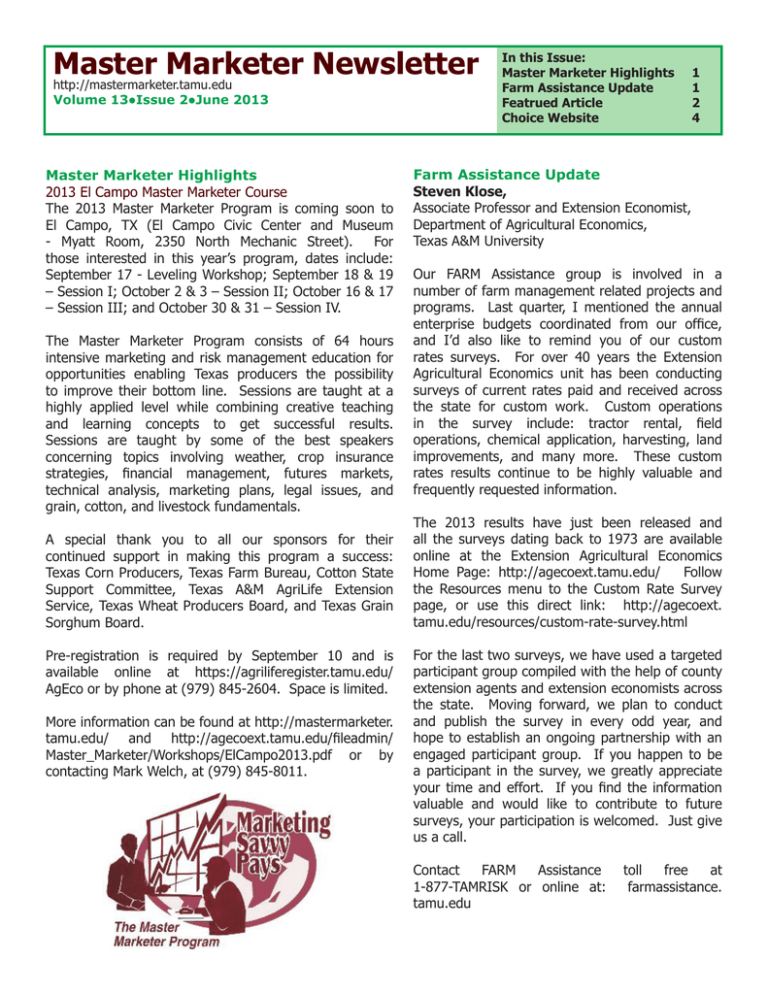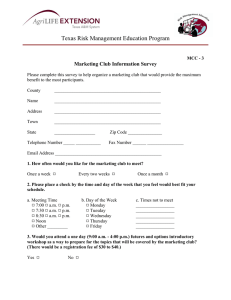Master Marketer Newsletter
advertisement

Master Marketer Newsletter http://mastermarketer.tamu.edu Volume 13lIssue 2lJune 2013 Master Marketer Highlights 2013 El Campo Master Marketer Course The 2013 Master Marketer Program is coming soon to El Campo, TX (El Campo Civic Center and Museum - Myatt Room, 2350 North Mechanic Street). For those interested in this year’s program, dates include: September 17 - Leveling Workshop; September 18 & 19 – Session I; October 2 & 3 – Session II; October 16 & 17 – Session III; and October 30 & 31 – Session IV. The Master Marketer Program consists of 64 hours intensive marketing and risk management education for opportunities enabling Texas producers the possibility to improve their bottom line. Sessions are taught at a highly applied level while combining creative teaching and learning concepts to get successful results. Sessions are taught by some of the best speakers concerning topics involving weather, crop insurance strategies, financial management, futures markets, technical analysis, marketing plans, legal issues, and grain, cotton, and livestock fundamentals. A special thank you to all our sponsors for their continued support in making this program a success: Texas Corn Producers, Texas Farm Bureau, Cotton State Support Committee, Texas A&M AgriLife Extension Service, Texas Wheat Producers Board, and Texas Grain Sorghum Board. Pre-registration is required by September 10 and is available online at https://agriliferegister.tamu.edu/ AgEco or by phone at (979) 845-2604. Space is limited. More information can be found at http://mastermarketer. tamu.edu/ and http://agecoext.tamu.edu/fileadmin/ Master_Marketer/Workshops/ElCampo2013.pdf or by contacting Mark Welch, at (979) 845-8011. In this Issue: Master Marketer Highlights Farm Assistance Update Featrued Article Choice Website 1 1 2 4 Farm Assistance Update Steven Klose, Associate Professor and Extension Economist, Department of Agricultural Economics, Texas A&M University Our FARM Assistance group is involved in a number of farm management related projects and programs. Last quarter, I mentioned the annual enterprise budgets coordinated from our office, and I’d also like to remind you of our custom rates surveys. For over 40 years the Extension Agricultural Economics unit has been conducting surveys of current rates paid and received across the state for custom work. Custom operations in the survey include: tractor rental, field operations, chemical application, harvesting, land improvements, and many more. These custom rates results continue to be highly valuable and frequently requested information. The 2013 results have just been released and all the surveys dating back to 1973 are available online at the Extension Agricultural Economics Home Page: http://agecoext.tamu.edu/ Follow the Resources menu to the Custom Rate Survey page, or use this direct link: http://agecoext. tamu.edu/resources/custom-rate-survey.html For the last two surveys, we have used a targeted participant group compiled with the help of county extension agents and extension economists across the state. Moving forward, we plan to conduct and publish the survey in every odd year, and hope to establish an ongoing partnership with an engaged participant group. If you happen to be a participant in the survey, we greatly appreciate your time and effort. If you find the information valuable and would like to contribute to future surveys, your participation is welcomed. Just give us a call. Contact FARM Assistance 1-877-TAMRISK or online at: tamu.edu toll free at farmassistance. Have Farmers Lost Confidence in Futures Markets? John Robinson, Emmy Williams, Mark Welch, Mark Waller, David Anderson, Dean McCorkle, Stan Bevers, Rob Hogan, Jackie Smith, and Steve Amosson The following excerpt is from an article reviewing the findings from a survey distributed in December 2012 to the past participants of the Texas A&M AgriLife Extension Service’s Master Marketer Program concerning their risk management strategies and changes in futures trading. To those who completed and returned the surveys, we thank you for your participation as this study would not have been possible without you. Recipients of the survey were asked to report the percent of production/utilization of any of the following commodities that were hedged during a given year using futures and options contracts. Findings show that in spite of increased volatility, convergence issues, and margin fund security, Master Marketer graduates trained in the use of futures and options are, generally, hedging more not less. In reporting the percent of total production that was hedged with either futures or options, an increase of about 10% for cotton, grain, and feeder cattle over the last 10 years was reported: cotton from the low teens to over 20%, feed grains (corn and sorghum) from the low 20% range to the mid-30s, wheat from the low teens to the mid-20s, and feeder cattle from the high 20s to high 30s (see Figure 3). The smallest increase was seen in hedging activity for live cattle and the largest increase in the ‘other’ category, primarily rice production. Questions were asked regarding Figure 3: Percent of production/utilization of any of the following commodities that the use of other marketing tools were hedged during a given year using futures and options contracts. for risk management in addition to or instead of futures and % options. Responses included 60 mostly cash contracts, marketing pools, crop insurance, and 50 grain storage. When asked if they used a marketing advisory Cotton service, 53% responded yes. 40 Feed Grains The critical question of the 30 survey, “Have you stopped or will you stop hedging 20 altogether?” was answered no by 84% of the respondents. When asked if they had replaced 10 or intended to replace futures/ options hedging with some other 0 risk management practices, cash contracting, pool marketing, and crop insurance were the leading responses. Wheat Live Cattle Feeder Cattle Natural Gas Other 2003 2004 2005 2006 2007 2008 2009 2010 2011 2012 Survey participants were asked to provide a scaled response to survey questions regarding disagreement or agreement (1 to 7, 1 = disagree, 7 = agree) with statements related to volatility, convergence and basis volatility and margin fund security (Figure 4). When asked if increased futures price volatility and associated margins and options premiums are a serious impediment to the use of futures or options markets for risk management, the average of responses was 5.0 reflecting agreement with that statement. Of the 122 who responded to that question, 63% responded with a scaled response of 5 or higher; 25% answered at level 7. The average response to the statement, “More variable basis and less reliable convergence between futures prices and cash prices are a serious impediment to my use of futures and options markets for risk management” was 4.8, less than Figure 4. Serious Impediments to the use of futures and options, average scaled response Fund Security Convergence Volatility the level of agreement on the volatility statement but expressed genera agreement. Of the 122 who responded to this statement, 57% rated their level of agreement 5 or higher, 18% rated their level of agreement a 7. On fund security, the average level of agreement with the statement, “Margin account security with a brokerage house is a serious impediment to my use of futures and options markets for risk management” was 4.1, a neutral response. Agreement was rated 5 or higher by 35% of 123 respondents, 11% agreed at level 7. Results Gross farm receipts, age and the intercept were 1 2 3 4 5 6 7 statistically significant at the 10% level. The Disagree Neutral Agree negative coefficient on the intercept indicates that those who have received Master Marketer training are not likely to have stopped hedging with futures and options in spite of volatility, convergence issues, and fund security. Farmers trained in the use of futures and options continue to use them as viable tools to manage price risk. The negative coefficient on gross farm receipts suggests that as farm income increases, a farmer is less likely to have stopped using futures and options for hedging. Larger farms have the resources to fund margin accounts and/or pay higher option premiums relative to smaller farms. Increasingly larger farms may be more professional in their approach to risk management, utilizing a broader range of tools, and better able to absorb the risk inherent in the current commodity price environment. Large farms may also be in the position of needing to manage price risk more so than a small farm. Conversely, the positive coefficient on age indicates an increased likelihood of stopping the use futures and options as a farmer gets older. Older farmers may be less willing to see the risk inherent with futures and options as acceptable given either their degree of wealth or goals associated with their business (retirement security versus growth). Older farmers may have a bias towards risk and prices set years ago by previous experience, in that option prices and margin requirements today are “just too high”. These findings are consistent with other studies that have found decreases in risk aversion as wealth increases and increases in risk aversion with advancing age (Martin and Eisenhauer, 2001; Riley and Chow, 1992). Older farmers may be in a financial position enabling them to ‘self-insure’ against price risk. Conclusion Many stakeholders in the futures industry—producers, commercial interests, legislators, regulators, the exchanges themselves—have expressed concern that traditional hedgers will abandon the futures market due to the concerns described above. While recent developments in the futures markets may have caused some farmers and ranchers to stop hedging with futures and options, this research suggests that those who have received intensive risk management training have not abandoned the futures market, but have in fact increased use. Farmers and ranchers that have stopped using futures and options markets report an increased use of other price risk management tools such as cash contracting, crop insurance, and marketing pools. The probability of continued use of futures and options for price risk management increases as gross farm receipts increase; the probability of continued use of futures and options decreases as farmers get older. A focus on understanding and using futures and options markets continues to be a viable component of risk management education. References Halek, Martin and Joseph G. Eisenhauer. “Demography of Risk Aversion”, The Journal of Risk and Insurance, Vol. 68, No. 1 (2001):1-24. Riley, William B. Jr. and K. Victor Chow. “Institute Asset Allocation and Individual Risk Aversion”, Financial Analysts Journal, Vol. 48, No. 6 (1992):32-37. 2124 TAMU, College Station TX 77843-2124 Prepared by: Emmy L. Williams, Extension Program Specialist and Dr. J. Mark Welch, Assistant Professor and Extension Economist-Grain Marketing Department of Agricultural Economics, Texas A&M AgriLife Extension Service, Texas A&M System, College Station, TX 77843-2124 If you would like to receive this newsletter by email, or have any other questions about the Master Marketer System, please contact Emmy Williams at emmywilliams@tamu.edu or (979) 847-6143. Choice Website Emmy Williams, Extension Specialist, Department of Agricultural Economics, Texas A&M University Farm Safety for Just Kids http://www.farmsafetyforjustkids.org/ As the summer months begin with children home on school break, we wanted to highlight this website containing friendly reminder tips on farm safety. The safety Educational Programs of Texas A&M AgriLife Extension Service are open to all citizens without regard to race, color, sex, disability, religion, age, or materials are available in electronic format and are targeted towards kids of different national origin. age ranges. The focus of Farm Safety Issued in furtherance of Cooperative Extension Work in Agriculture and for Just Kids is the prevention of farm Home Economics, Acts of Congress of May 8, 1914, as amended, and June accidents by promoting a safe environment 30, 1914, in cooperation with the United States Department of Agriculture through education. Topics include animal, and Texas A&M AgriLife Extension Service, Texas A&M System. ATV, chemical, and tractor safety along Partial funding support for the Master Marketer program has been with many other additional safety issues. provided by RMA-USDA, Cotton Inc.-Texas State Support Committee, With so many families involved in farm Texas Farm Bureau, Texas Corn Producers, Texas Grain Sorghum operations, we encourage the safest of Producers, and Texas Wheat Producers Board. practices for both the young and old alike. An archive of newsletters can be found online by visiting http://agecoext.tamu.edu/programs/marketing/master-marketerprogram/newsletter-archives.html




